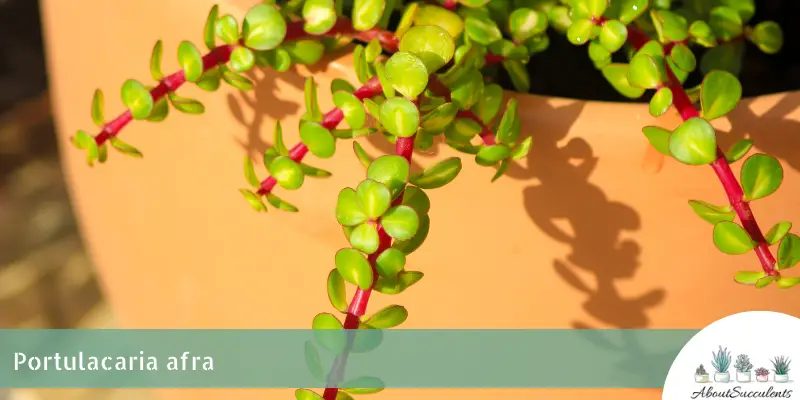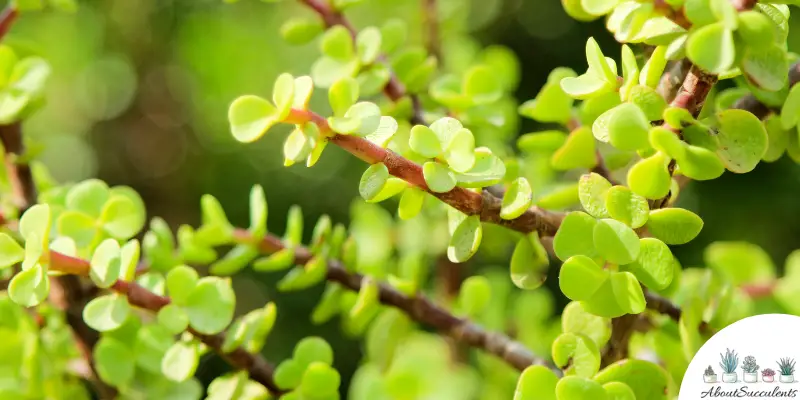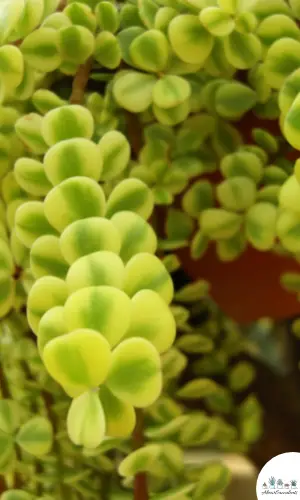
Portulacaria afra is an interesting-looking succulent that has plump, fleshy, and glossy leaves and grows as a small bush. It is called Elephant Bush because, in the wild, Portulacaria afra is the favorite food of elephants.
Another name for the plant is Rainbow Bush because of the many small flowers that it produces which range in color from pale pink to purple.
The succulent has thick, brownish-colored stems that have small tender green leaves which give Elephant Bush the appearance of a small jade plant. Portulacaria afra can grow to a height of 12-feet or 3.6m tall.
Portulacaria afra comes from the Portulacaceae family and is native to the eastern part of South Africa and the Limpopo province from the Eastern cape going northward.
General Information
Also known as: Elephant Bush, Rainbow Bush, Dwarf Jade Plant.
Plant Family: Portulacaceae
Origin: Native to the eastern part of South Africa and the Limpopo province from the Eastern cape going northward.
Height: 12-feet or 3.6m tall
Exposure: Partial sunlight up to 6 hours
Water Needs: Frequent watering schedule during the summer months; very little to no watering in the winter or cold season.
Soil Type: Potting soil, cactus soil or sandy soil
Soil pH: Mildly Acidic (5.6 to 6.5 pH)
Tolerance: Drought; cannot tolerate frost
How to Grow and Care for Portulacaria Afra

Portulacaria afra can be grown outdoors or indoors. As an outdoor succulent, Portulacaria afra is a perfect addition to a miniature garden or rock garden.
Elephant Bush is not a cold-hardy succulent. If the temperature in your region drops below 30° F or 1.7° C, it would be best if the succulent is planted in a pot that can be brought indoors.
You can also use Portulacaria afra as a hanging plant and allow its long stems to extend downward. It will be a wonderful ornament for your patio.
1. Sunlight
Portulacaria afra responds well to partial or full sunlight. If grown outdoors, plant Portulacaria afra in a location that gets 6 hours of sunlight.
If Elephant Bush is grown indoors, place the pot in an area in a room with a warm temperature. Position the plant near a window that gets indirect sunlight.
2. Watering

Portulacaria afra is a succulent that is highly resistant to drought. You don’t have to give it plenty of water to thrive. Elephant Bush can adapt to both dry and hot conditions.
As a rule, Portulacaria afra will require more water during the summer months. Like other succulents, give the plant water only when the soil is free of moisture.
In the winter months, reduce Elephant Bush’s watering schedule because the soil stays moist much longer.
To keep your Portulacaria afra succulent healthy, feed the soil with fertilizer that has been diluted with water to reduce its strength by 50%. Fertilizer should only be given during the early spring or late winter.
3. Pot and Soil
Plant Portulacaria afra in a pot that has excellent draining properties. The succulent cannot stay in moist soil for a long period. Otherwise, its roots may rot and infect the entire plant.
Use a rock or a stake to keep Elephant Bush stable and upright because its thick stems and succulent leaves add more weight to its top. The stake can keep the plant upright and stable until such time that it becomes well-rooted in the soil.
The best soil to use would be well-draining potting soil, cactus soil or sandy soil which are all well-draining and allow proper air circulation around Portulacaria afra’s roots.
It is recommended to repot Portulacaria afra every 2 years to ensure that the succulent is getting sufficient nutrients from the soil.
How to Propagate Portulacaria Afra
Keeping Portulacaria afra indoors has another benefit: it is reported that Elephant Bush can absorb dangerous carbon monoxide particles in the air. The succulent is sometimes described as a “carbon sponge”.
If you want to keep the air inside your house, outside your patio and garden clean, grow more Portulacaria afra.
The good news is, it is easy to propagate the Portulacaria afra by using the stem cuttings method.
Step 1: Cut a stem using a sterilized and sharpened knife or garden shears.
Step 2: Place the stem under a shaded area and let it dry. The process of naturally drying the stem will help it develop calluses that are necessary for propagation. It will take several days for the stem to have calluses.
Step 3: Once the calluses have developed on the stem, place it in a pot of well-draining soil.
Step 4: Keep the plant out of direct sunlight while it is setting its roots. This process will take 4 to 6 weeks.
Step 5: Give the plant water whenever the soil feels dry to the touch.
Frequently Asked Questions
Is Portulacaria Afra Toxic to Cats and Dogs?
Portulacaria afra does not appear in the American Society for the Prevention of Cruelty to Animal (ASPCA) website’s list of toxic plants which means it could be safe for your cats or dogs.
The list is not all-inclusive and only includes plants that are frequently asked about. If your pet experiences gastrointestinal distress or vomiting when it comes in contact with Elephant Bush, please consult with a veterinarian right away.
An interesting piece of information about Portulacaria afra is that it is an ingredient in South African cuisine. Elephant Bush is often added as a flavoring for stews and soups and as part of a salad.
Why is my Portulacaria Afra Dying?
There are 3 possible causes of death for your Elephant Bush: Overwatering, underwatering, and pest infestation.
1. Overwatering
If the leaves of the Portulacaria afra are turning yellow, its roots could be starting to rot due to overwatering. Another symptom of overwatering is the succulent’s leaves falling.
Cut out any part of the plant that shows deterioration or infection. If left unattended, the infected area could spread and contaminate the entire plant.
2. Underwatering
The leaves of Portulacaria afra can dry up and shrivel and eventually, fall off if it does not receive enough water.
Perform frequent checks on the dryness of the soil. Check if the top layer of the soil is dry to the touch before giving the plant water.
3. Pest Infestation
Portulacaria afra attracts mealybugs, spider mites, and whiteflies. Brush off the mealybugs from the leaves by wiping them with a cotton ball dipped in denatured alcohol.
A mild insecticide may get rid of the spider mites and whiteflies. If Elephant Bush is located in a garden with other succulents, transfer the pot to another location to prevent the pests from transferring to the rest of your plants.
The brownish-red stems of Portulacaria afra produce clusters of small flowers that vary in color from pink to purple to white. Elephant Bush usually blooms during the summer months.
Last Updated on June 14, 2022 by Sofia Lara